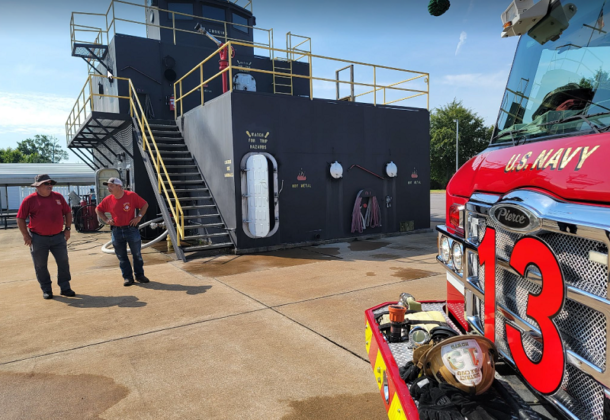NAS Pax Trains for Firefighting at Sea

“Every Sailor a Damage Controlman” goes the adage for seagoing personnel, referring to every sailor’s responsibility in responding to emergencies aboard ship. Firefighters at NAS Patuxent River took that to heart when they completed shipboard firefighting training July, despite being a stationed on a shore-based air installation.
“After hearing of the events taking place in San Diego with the USS Bonhomme Richard, Patuxent River Fire and Emergency Services wanted to ensure our personnel are at a state of readiness if an incident similar to that event ever took place on our facility,” said Fire Capt. James Barnes of the Naval District Washington Fire Department at NAS Patuxent River. “Our firefighters pride ourselves at always staying at a high state of readiness and will do what it takes to ensure we continue to be ready for any emergency that may take place at Patuxent River, Webster Field, or to our surrounding mutual aid partners.”
To accomplish this, 25 firefighters from NAS Pax River attended shipboard firefighting training at the Seafarers Harry Lundeberg School of Seamanship in Piney Point, MD, a vocational school dedicated to preparing students for careers as US merchant mariners.
The Pax River firefighters built upon a close working relationship with the staff that runs the Joseph Sacco Firefighting and Safety Training School at SHLSS, which specializes in maritime shipboard firefighting tactics.
“Our crews attend structural fire simulations, aircraft fire simulations, and car fire simulations throughout the year but we rarely have an opportunity to train with live fire in a shipboard setting,” Fire Capt. Barnes said. “The Joseph Sacco Firefighting and Safety Training School specializes in such training. Before the live fire scenario, crews were briefed on best practices, what to expect, and what situations they can expect on a large vessel should a major incident take place. Training included shipboard firefighting tactics, rescue considerations while conducting shipboard firefighting, and also best practices to conserve and protect property.”
It might seem overly cautious for firefighters on an air station to undertake specialized shipboard firefighting training, but NAS Patuxent River’s operations are not only limited to the air and ground.
“We have a number of assets at Pax that are waterborne,” said Chief Aviation Structural Mechanic Brandon Higdon, NAS Patuxent River port operations leading chief petty officer. “In addition to our Port Ops small craft and those of our mission partners, we also regularly work with barges on the Patuxent River. As anyone who has been to sea can tell you, there is no such thing as ‘too prepared’ when considering safety aboard a ship.”
The firefighters took these operations into effect while planning realistic training scenarios specific to Pax River. The crews focused on a ship fire that could take place at the West Basin Marina off of Dock D. The preparation for this scenario was unique as crews would be utilizing close to 1,100 feet of various size firefighting hose as well as multiple firefighting appliances. To accomplish that, they deployed a hose load called a “leader-line,” allowing them to reach and extend the hose line over great distances to such a fire.
“We usually like to prepare for the worst-case scenario and work our way back from there,” Fire Capt. Barnes said. “If we do that, we’ll be ready for anything, and now that specialized training is complete, I’m confident that our crews can attack any and all situations regarding a major maritime incident at Patuxent River or Webster Field. Thanks to our working with our mutual aid partners and making connections we’ve been able to participate in this specialized training which allows our crew to be in the best possible state of readiness to protect our fellow Pax pros.”
This article was written by Patrick Gordon, NAS Patuxent River public affairs officer.






















